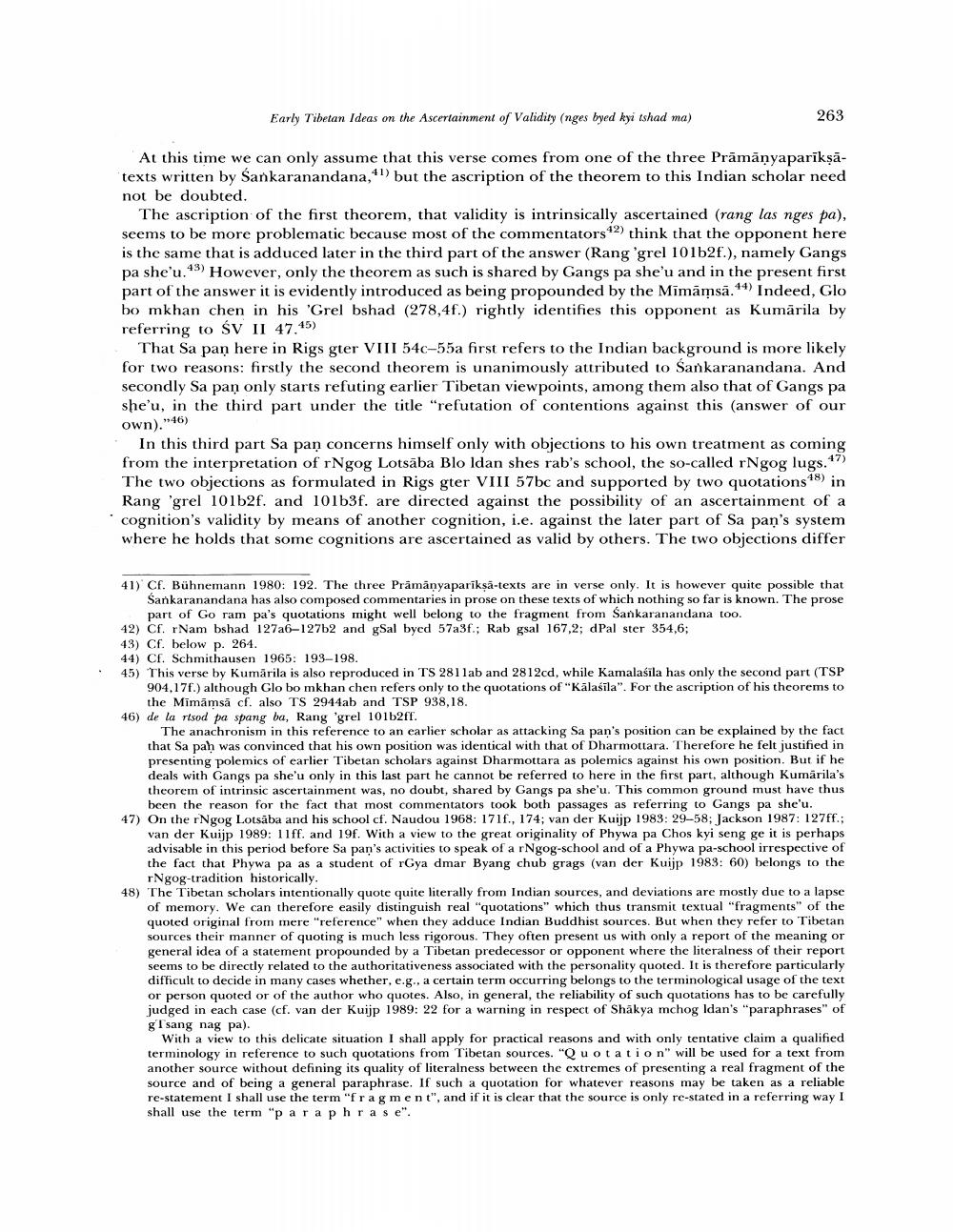Book Title: Early Tibetan Ideas On Ascertainment Of Validity Author(s): Ernst Steinkellner Publisher: Ernst Steinkellner View full book textPage 7
________________ Early Tibetan Ideas on the Ascertainment of Validity (nges byed kyi tshad ma) 263 At this time we can only assume that this verse comes from one of the three Prāmāṇyaparīkņātexts written by Sankaranandana,4l) but the ascription of the theorem to this Indian scholar need not be doubted. The ascription of the first theorem, that validity is intrinsically ascertained (rang las nges pa), seems to be more problematic because most of the commentators 2) think that the opponent here is the same that is adduced later in the third part of the answer (Rang'grel 101b2f.), namely Gangs pa she'u.43) However, only the theorem as such is shared by Gangs pa she'u and in the present first part of the answer it is evidently introduced as being propounded by the Mimāmsā.44) Indeed, Glo bo mkhan chen in his 'Grel bshad (278,4f.) rightly identifies this opponent as Kumārila by referring to SV II 47.45) That Sa paņ here in Rigs gter VIII 54c-55a first refers to the Indian background is more likely for two reasons: firstly the second theorem is unanimously attributed to Sankaranandana. And secondly Sa paņ only starts refuting earlier Tibetan viewpoints, among them also that of Gangs pa she'u, in the third part under the title "refutation of contentions against this answer of our own)."46) In this third part Sa paņ concerns himself only with objections to his own treatment as coming from the interpretation of rNgog Lotsāba Blo ldan shes rab's school, the so-called rNgog lugs.) The two objections as formulated in Rigs gter VIII 57bc and supported by two quotations 8) in Rang 'grel 101b2f. and 101b3f. are directed against the possibility of an ascertainment of a cognition's validity by means of another cognition, i.e. against the later part of Sa pan's system where he holds that some cognitions are ascertained as valid by others. The two objections differ 41) Cf. Bühnemann 1980: 192. The three Prämānyapariksā-texts are in verse only. It is however quite possible that Sankaranandana has also composed commentaries in prose on these texts of which nothing so far is known. The prose part of Go ram pa's quotations might well belong to the fragment from Sankaranandana too. 42) Cf. rNam bshad 127a6-127b2 and gSal byed 57a3f.; Rab gsal 167,2; dPal ster 354,6; 43) Cf. below p. 264. 44) CF. Schmithausen 1965: 193-198. 45) This verse by Kumārila is also reproduced in TS 281 lab and 2812cd, while Kamalasila has only the second part (TSP 904,17f.) although Glo bo mkhan chen refers only to the quotations of "Kālasila". For the ascription of his theorems to the Mimāmsā cf. also TS 2944ab and TSP 938,18. 46) de la risod pa spang ba, Rang 'grel 101b2f1. The anachronism in this reference to an earlier scholar as attacking Sa pan's position can be explained by the fact that Sa pah was convinced that his own position was identical with that of Dharmottara. Therefore he felt justified in presenting polemics of earlier Tibetan scholars against Dharmottara as polemics against his own position. But if he deals with Gangs pa she'u only in this last part he cannot be referred to here in the first part, although Kumarila's theorem of intrinsic ascertainment was, no doubt, shared by Gangs pa she'u. This common ground must have thus been the reason for the fact that most commentators took both passages as referring to Gangs pa she'u. On the rNgog Lotsāba and his school cf. Naudou 1968: 171f., 174; van der Kuijp 1983: 29-58; Jackson 1987: 127ff.; van der Kuijp 1989: 11 ff. and 19f. With a view to the great originality of Phywa pa Chos kyi seng ge it is perhaps advisable in this period before Sa pan's activities to speak of a rNgog-school and of a Phywa pa-school irrespective of the fact that Phywa pa as a student of rGya dmar Byang chub grags (van der Kuijp 1983: 60) belongs to the rNgog-tradition historically. 48) The Tibetan scholars intentionally quote quite literally from Indian sources, and deviations are mostly due to a lapse of memory. We can therefore easily distinguish real "quotations" which thus transmit textual "fragments" of the quoted original from mere "reference" when they adduce Indian Buddhist sources. But when they refer to Tibetan s their manner of quoting is much less rigorous. They often present us with only a report of the meaning or general idea of a statement propounded by a Tibetan predecessor or opponent where the literalness of their report seems to be directly related to the authoritativeness associated with the personality quoted. It is therefore particularly difficult to decide in many cases whether, e.g., a certain term occurring belongs to the terminological usage of the text or person quoted or of the author who quotes. Also, in general, the reliability of such quotations has to be carefully judged in each case (cf. van der Kuijp 1989: 22 for a warning in respect of Shakya mchog Idan's "paraphrases" of g Isang nag pa). With a view to this delicate situation I shall apply for practical reasons and with only tentative claim a qualified terminology in reference to such quotations from Tibetan sources. "Quotation" will be used for a text from another source without defining its quality of literalness between the extremes of presenting a real fragment of the source and of being a general paraphrase. If such a quotation for whatever reasons may be taken as a reliable re-statement I shall use the term "fragment", and if it is clear that the source is only re-stated in a referring way I shall use the term "paraphrase".Page Navigation
1 ... 5 6 7 8 9 10 11 12 13 14 15 16 17
